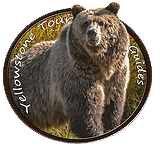Yellowstone Tour Guide Saves Aids Motorist from Grizzly Bear Attack
Yellowstone Tour Guide Saves Aids Motorist from Grizzly Bear Attack
Yellowstone National Park is known for its stunning landscapes and abundant wildlife. Visitors flock to the park to experience the beauty of nature up close. However, venturing into the wilderness can sometimes be dangerous, especially when encountering predators like grizzly bears. In a recent incident, a Yellowstone tour guide played a heroic role in saving a motorist from a grizzly bear attack. This remarkable story showcases the importance of knowledgeable guides and the measures to take when encountering wildlife in their natural habitat.
The Grizzly Bear Encounter
Imagine driving along the scenic roads of Yellowstone National Park, enjoying the breathtaking views, when suddenly, a grizzly bear appears out of nowhere. This is exactly what happened to a motorist who found themselves face-to-face with a grizzly bear while exploring the park. Panic and fear must have overwhelmed the motorist as they realized they were in a dangerous situation.
The Quick Thinking of the Tour Guide
Fortunately, a Yellowstone tour guide happened to be in the vicinity and witnessed the imminent danger. The tour guide, well-versed in park regulations and safety protocols, quickly assessed the situation and sprang into action. Understanding the potential threat posed by the grizzly bear, the guide knew the importance of remaining calm and taking the appropriate steps to ensure everyone’s safety.
Keeping a Safe Distance
One crucial aspect of wildlife encounters is maintaining a safe distance. The tour guide, well-trained in wildlife behavior, knew that grizzly bears are powerful apex predators and can be unpredictable. By instructing the motorist to stay inside their vehicle and not make any sudden movements, the guide created a barrier between the bear and the potential victim. This helped prevent the situation from escalating further.
Distracting the Bear
In an attempt to divert the grizzly bear’s attention away from the motorist, the tour guide utilized their knowledge of wildlife behavior. They knew that making loud noises, blowing a whistle, or using an air horn could potentially startle the bear and cause it to retreat. By employing these techniques, the guide successfully drew the bear’s attention away from the motorist, buying precious moments to assess the situation and plan for the next steps.
Contacting Park Rangers
While the tour guide’s quick thinking and actions were commendable, it is essential to remember that wildlife encounters in national parks should always be reported to park officials. Following the incident, the tour guide immediately contacted park rangers to inform them of the bear encounter and provide crucial details about the incident. This allowed the rangers to assess the bear’s behavior and take appropriate measures to ensure the safety of park visitors.
Staying Informed and Prepared
Encounters with wildlife can happen unexpectedly, and it is crucial for visitors to national parks to be well-informed and prepared. The incident serves as a reminder for tourists to familiarize themselves with park regulations and guidelines, especially regarding wildlife encounters. Understanding the do’s and don’ts when encountering animals in their natural habitat can significantly reduce the risk of dangerous encounters.
The Role of Knowledgeable Guides
The heroic act of the Yellowstone tour guide highlights the importance of having knowledgeable guides in national parks. These guides possess extensive knowledge of the park, its wildlife, and the necessary safety measures. They play an essential role in educating visitors, ensuring that they have a safe and enjoyable experience while respecting the wildlife and preserving the natural environment.
Conclusion
The Yellowstone tour guide’s bravery and quick thinking in saving a motorist from a grizzly bear attack demonstrate the importance of having knowledgeable guides and following proper safety protocols when encountering wildlife in their natural habitat. National parks are home to diverse and sometimes dangerous wildlife, and it is crucial for visitors to be informed, prepared, and respectful of these magnificent creatures. Through responsible tourism and the guidance of experienced professionals, we can continue to enjoy the wonders of nature while prioritizing safety and conservation.
